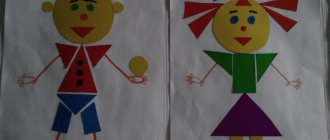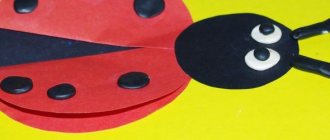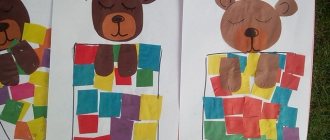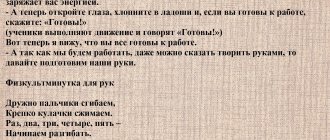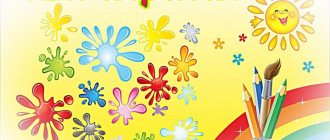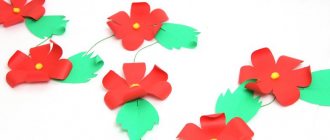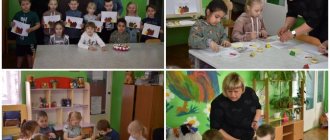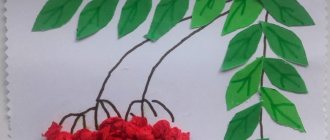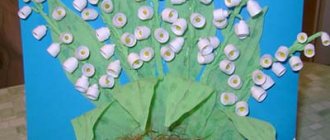Appliquéing a person is a very exciting and creative job. Its advantage is the variety of techniques used and varying complexity. Such work is suitable for very young children, preschoolers and elementary school students. Using the application, you can study geometric shapes, colors, parts of a person’s face, and his emotions.
Application of geometric shapes
The simplest version of a person’s appliqué is made from geometric shapes. This technique helps develop a child's imagination. The main elements used are square, triangle, circle, and rectangles.
For the application you will need:
- patterns of triangles, circles,
- cardboard;
- glue.
The complexity of the work depends on the number of parts and elements used. The simplest option is to invite the child to arrange the figures so that they form a body, head, arms and legs. A rectangle (boy figure) or a triangle (girl figure) is used as a body. Instead of a head there is a circle. The arms and legs are made from thin rectangles.
They complicate the work with various details - pigtails, a hat, highlighting the hands and feet. Small details indicate the eyes, mouth, nose.
GCD in the middle group on the application “Let's help paper people”
Summary of the educational event itself
on application in the middle group
on the topic: “Let’s help paper people”
Program content:
Continue to teach children how to create a given structure using a diagram of geometric shapes.
Practice orientation in space on a sheet of paper.
Strengthen skills in working with scissors, paper and glue;
colors and shapes; the ability to complement the craft with details that match the image.
Involve children in visual analysis of the sample.
Develop visual perception, attention, artistic imagination and aesthetic taste;
Cultivate accuracy in work, the ability to complete a task started, and a desire to help little people.
Progress of the lesson:
Educator: Guys, look, we have received a package from a paper fairy, and in it is a letter-signal sos. Are you wondering what's in this letter? Then let's open it. (The teacher opens the letter and reads it)
- "Hello guys! In our country, everything is made of paper: houses, clothes, transport and everything, everything, everything.
One of the inhabitants of the paper planet was playing with matches, a fire broke out, he himself got burned and all our houses burned down.
Now we have nowhere to live. We really ask you guys to help us.
I am sending paper people to you so that you can tell them how to behave correctly, a photo of the house and its details.
Educator: Do you think we can fulfill this request? (children agree)
Conversation about upcoming work.
Let's take a closer look at the photo:
Guys, look at the picture of the house and tell me what geometric figure the details of the house resemble?
Is the house one-story or multi-story?
Name: what parts, what shape and color does the house consist of (the base of the house is a yellow rectangle, the triangular roof is orange, the window is round, pink, the doors are brown, rectangular, the curtains are white).
But the trouble is that the Fairy was in such a hurry that she did not include all the necessary parts:
Instead of a triangular roof, she put an orange square, and instead of doors, she put a long brown strip of paper.
What needs to be done with a square to get a triangle? With a long brown stripe to get the doors?
In what order do you think we will perform the appliqué? (what we glue first, what second…..)
Everyone will build their own little house.
I know that you are kind and caring guys, and you will cope with the task.
-Who builds houses? (builders). This means that today we will be builders, we will build a model of a house.
To make the houses beautiful, let’s prepare the fingers.
Warm-up:
Face: studying the senses and emotions
Appliquing a person's face from paper is not just an interesting creativity, but also an opportunity for a child to develop in different areas. To get acquainted with the senses and emotions, children are asked to do a simple job - stick eyes, mouth, nose, ears on a template.
Classes can be divided into 2 types depending on age:
- familiarization with the location of organs;
- game of emotions.
Getting to know the location of the senses
Familiarity with the location and purpose of the senses is necessary for children aged 2-3 years. During this period, work is performed with the help of an adult.
For the application you will need:
- face template;
- templates of mouth, eyes, nose, ears;
- glue.
To begin with, the child is shown a template of a face and told that the sense organs are located on it. They show the organs one by one, explain their purpose and location, and let you look at them. The child applies glue to the template and sticks it to the face. The actions are repeated with each sense organ.
Getting to Know Emotions
The application of a person's emotional face will be of interest to children aged 4-5 years. To work, you will need to prepare in advance templates of the eyes and mouth, expressing various emotions - anger, joy, sadness. Also, for the applique you will need a person's face made of paper. It may have a nose drawn on it in advance.
- Work begins with one emotion. It is described in detail. They tell how this feeling is expressed through the eyes and mouth.
- They invite the child to choose from a general set of templates that are suitable in meaning and place them on his face. If it turned out correctly, move on to the next emotion.
- If a child has made a mistake, then it must be discussed and helped to correct it.
Playing with emotions is interesting not only in the form of applique, but also with magnetic templates or Velcro parts.
Man in motion
The appliqué of a person in motion helps develop a child’s creative abilities and imaginative perception. The difficulty of this task is that rectangles and squares of different sizes are used for the work.
For the application you will need:
- blanks of squares and rectangles made of paper;
- cardboard;
- glue.
The work consists of several stages:
- The child is asked to choose cardboard - the base on which he will stick the figure.
- The adult pronounces the pose that will be depicted in the form of an appliqué. He explains how the arms and legs are positioned in this pose, and what features there are. For example: a person runs, bends over, jumps.
- The child takes the prepared templates and lays them out in the desired position on the cardboard. If you have completed the figure correctly, then glue the rectangles with glue.
- If mistakes are made in a pose, the adult tells you how to correct it.
The application of a person in motion will be useful for children of primary school age and art students.
MAGAZINE Preschooler.RF
Educational field “Artistic creativity” (Lesson type: final)PROGRAM CONTENT: 1. Create conditions for successful motivation of practical activities. 2. Teach children to invent and portray fantastic people. 3. Develop and improve the skills and abilities of constructive and design creativity, using the tearing method. 4. Express the character of the characters in the application with gestures and movements. 5. Develop children's creative activity, independence and initiative. MATERIAL: 1. Toy Bon – Bon (made of cardboard, candy wrappers, candies). 2. Models (take a candy wrapper, fold the candy wrapper crosswise in three, iron the fold and tear it into three parts. From the middle part we get the head and torso. We bend the side parts lengthwise and tear them in half. We bend the resulting parts in half again and also tear them. We got two “arms" and two “legs” that can bend and unbend. We put together a “candy man” from torn pieces). HOD: Guys, what are you in the mood for? Show how cheerful you are (crying is heard behind the doors) Guys, you are all cheerful, but who is crying then? I'll go and have a look (I bring in the Bon-Bon toy) Bon: Hello, guys, my name is Bon-Bon. Educator: What happened to you, why are you crying? Bon: I lost my Caramel Country. Educator: Look, this is not your country? Bon: No, but I like her too, but I’ll be bored alone. Educator: Guys, why will Bon be bored? Do you like to play alone? Why? How can we help Bon-Bon? Only I have nothing (at this time there is noise). What sounds? I don’t know, maybe you know? What could be rustling like that? Oh, look, there’s some beautiful box lying here. Let's open it. That's where the noise was coming from. These are candy wrappers. Do you think candy men look just like people? That's right, like real people, they have all the parts of their body that should be in their place. What parts of the body do you know? How many arms and legs? Can your head tilt and can your arms and legs bend? Move your head, arms, legs. Now let's go to the tables, and put Bon - Bon here, he will watch how you make little men. Look how an ordinary candy wrapper turns into a little man (I show models). Before we start, let's play with our fingers. One, two, three, four, five Let's count fingers Strong, friendly Everyone is so necessary. Now let’s start creating our own caramel man (to instrumental music). Our most delicious caramel country is located on the table, come up and stick your sweet inhabitants. Do you like our caramel country? With what? What mood are your people in? Do you think Bon-Bon will like her? Let's call him. Guys! Look, Bon—Bon smiled. Bon: What a beautiful caramel country. I like her, I'm so happy. Thank you very much. I also want to give you a gift. Here's a sweet caramel for you. Educator: Oh, there are many of us, but there is only one candy. Wait, there's something in it. Let's see (I'll treat you to caramel). Let's dance with caramels (to music). Guys, now you know that you don’t need to throw away candy wrappers, but you can make many, many funny caramel men out of them and play with them. Thank you.
| Next > |
Studying anatomy
Older children will be interested in studying human anatomy using the applique as an example. This game will not only develop fine motor skills and perseverance, but will also introduce children to the structure of internal organs.
Depending on age and level of training, the number of organs may vary. To play you will need:
- template (contours of the human body);
- organs (brain, stomach, lungs, liver, heart, intestines and others);
- diagram with the location of organs on the template and their names;
- glue.
The essence of the game is to introduce the child to internal organs.
- Each organ is taken in turn. Its name is clearly pronounced and shown on the diagram where it should be located. For older children, the purpose of this organ is explained.
- The child takes the organ shown and glues it onto the person’s stencil for appliqué.
- The actions are repeated with each organ.
If this is not the first time an acquaintance with the internal structure of a person occurs, then the child can be asked to independently glue the organs onto the template.
Movable little man
Patterns of human body parts can make applique more interesting for children. With their help, it is possible to achieve a realistic, bright picture or give it dynamics. Surely older children will enjoy the dynamic applique.
To work you will need:
- templates of body parts (arms, legs, torso, head);
- screws and nuts from a metal constructor;
- cardboard;
- glue;
- scissors.
The work is carried out in several stages:
- Templates printed on paper are cut out and glued onto thick cardboard. This makes them stronger. Then the parts are cut out of cardboard.
- Place your hands on the body and use sharp scissors to make a through hole. A screw is inserted into it and a nut is tightened. I repeat the operation with my legs.
- The head is attached to the body in a similar way.
The little man gains mobility and is ready to play. To complicate the work, you can create additional connections at the elbows and knees.
Applications are a fascinating creativity that develops imaginative thinking, perseverance, and fine motor skills. Working with paper is suitable for children of all ages. Having mastered the skills of appliqué on paper, you can move on to more interesting and complex activities - for example, creating a reusable game with felt Velcro.
Man in motion: people in different poses
The main elements for implementing this technique are shapes: squares, rectangles and wide stripes. Therefore, this technique partially relates to geometric appliqué. The easiest way is to prepare blanks for the first trial work from a notebook sheet in a box. There are already markings there, you just need to cut out the necessary shapes.
As a lesson, explain how certain parts of the body are depicted during movement. Why does this happen and for what purpose? From a number of similar works on a specific topic, you can make an entertaining panel dedicated to sports, family relationships or friends.
